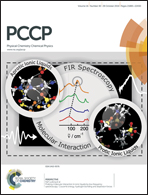On the trends of Fukui potential and hardness potential derivatives in isolated atoms vs. atoms in molecules
Abstract
In the present study, trends of electronic contribution to molecular electrostatic potential [Vel(![[r with combining macron]](https://www.rsc.org/images/entities/i_char_0072_0304.gif) )r=0], Fukui potential [v+f|r=0 and v−f|r=0] and hardness potential derivatives [Δ+h(k) and Δ−h(k)] for isolated atoms as well as atoms in molecules are investigated. The generated numerical values of these three reactivity descriptors in these two electronically different situations are critically analyzed through the relevant formalism. Values of Vel(
)r=0], Fukui potential [v+f|r=0 and v−f|r=0] and hardness potential derivatives [Δ+h(k) and Δ−h(k)] for isolated atoms as well as atoms in molecules are investigated. The generated numerical values of these three reactivity descriptors in these two electronically different situations are critically analyzed through the relevant formalism. Values of Vel(![[r with combining macron]](https://www.rsc.org/images/entities/i_char_0072_0304.gif) ) (when r → 0, i.e., on the nucleus) are higher for atoms in molecules than that of isolated atoms. In contrast, higher values of v+f|r=0 and v−f|r=0 are observed for isolated atoms compared to the values for atoms in a molecule. However, no such regular trend is observed for the Δ+h(k) and Δ−h(k) values, which is attributed to the uncertainty in the Fukui function values of atoms in molecules. The sum of Fukui potential and the sum of hardness potential derivatives in molecules are also critically analyzed, which shows the efficacy of orbital relaxation effects in quantifying the values of these parameters. The chemical consequence of the observed trends of these descriptors in interpreting electron delocalization, electronic relaxation and non-negativity of atomic Fukui function indices is also touched upon. Several commonly used molecules containing carbon as well as heteroatoms are chosen to make the investigation more insightful.
) (when r → 0, i.e., on the nucleus) are higher for atoms in molecules than that of isolated atoms. In contrast, higher values of v+f|r=0 and v−f|r=0 are observed for isolated atoms compared to the values for atoms in a molecule. However, no such regular trend is observed for the Δ+h(k) and Δ−h(k) values, which is attributed to the uncertainty in the Fukui function values of atoms in molecules. The sum of Fukui potential and the sum of hardness potential derivatives in molecules are also critically analyzed, which shows the efficacy of orbital relaxation effects in quantifying the values of these parameters. The chemical consequence of the observed trends of these descriptors in interpreting electron delocalization, electronic relaxation and non-negativity of atomic Fukui function indices is also touched upon. Several commonly used molecules containing carbon as well as heteroatoms are chosen to make the investigation more insightful.


 Please wait while we load your content...
Please wait while we load your content...